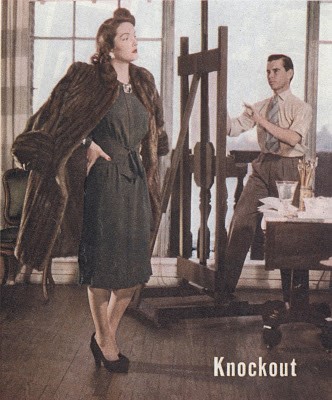The Art of the Post: The Saddest Cover
My candidate for the saddest cover of the Post is this painting by Gilbert Bundy of a WAC looking over her shoulder at a frivolous hat in a store window.

The determined WAC is headed off to do her duty. Her thoughtful expression suggests she’s a little wistful about the pretty things she is leaving behind. But what makes that so tragic?
The artist, Gilbert Bundy, earned fame in the 1930s for his light-hearted watercolor cartoons of beautiful women in high society scenes.

He seemed to take particular pleasure in painting floral arrangements:

Photos from the social pages of the time show the handsome young illustrator at parties, dressed in his tuxedo and escorting lovely young socialites. Here we see him in his studio painting one of his elegant models:

His charmed life continued as he fell in love, married, and had a baby daughter. The future looked good.
But when World War II began, the stakes changed. We can’t know exactly what was going through Bundy’s mind as he painted that cover for the Post. All we know is that, like the WAC in his painting, Bundy decided to abandon his civilian life painting pretty girls and go to war. He volunteered to work as a war artist covering the South Pacific for Hearst newspapers.

In 1944, Bundy was participating in the Marine invasion of the island of Tarawa when a Japanese shell exploded in his small landing craft. Bundy awoke to find himself trapped beneath the bodies of four Marines. The wreckage of the craft had drifted onto a coral reef within range of enemy gunners on the island. For most of that long day, Bundy remained pinned beneath corpses and drenched with blood, as enemy bullets and shells strafed the remnants of the craft. When night came, Bundy managed to free himself and swam away from the wreck, taking his chances spending a night alone in shark infested waters rather than endure another day under enemy fire.
The Hearst newspaper reported, “He was believed dead for three days. His reappearance startled his Marine mates.”
Bundy was shipped back to the U.S. where he tried to return to his previous life. He painted a series of illustrations of light-hearted romantic stories for the Post.

For the story, “Good Time Girl” by Lester Atwell, which appeared in the Post on January 31, 1948, Bundy painted a woman in a fur coat standing in front of a three-way mirror. After a couple of unsatisfactory attempts, he decided to paint the woman three times: “I finally posed my model backward or sidewise in three separate poses, one for each panel of the mirror, and worked direct. Then I combined the three to get the triple-reflection effect.”

His challenge, Bundy reported, was painting a pair of beautiful legs from three different angles. Who could ask for a more fun job?
But beneath the surface Bundy remained haunted by his wartime experience.
On the anniversary of his ordeal, Bundy committed suicide and rejoined his fallen comrades.
In hindsight, his Post cover about the WAC has a tragic air. The WAC was taking a last lingering look at civilian pleasures as she responded to the call of duty. Whatever was going through Bundy’s mind as he painted, he couldn’t know what horrors lay in store for him. His refined fingers, so well suited for painting delicate pictures of flowers and shapely girls, were not well suited for clawing their way out from under corpses.
Comparing his illustrations before and after the war, we see that his art lost much of its confidence and certainty. Gone was the joyful exuberance. His deft brush strokes became labored and heavy handed. His pictures—like his life—seemed to lose their balance and proportion.
If you or a loved one is struggling with thoughts of suicide, you’re not alone. Call the National Suicide Prevention Lifeline at 1-800-273-8255.